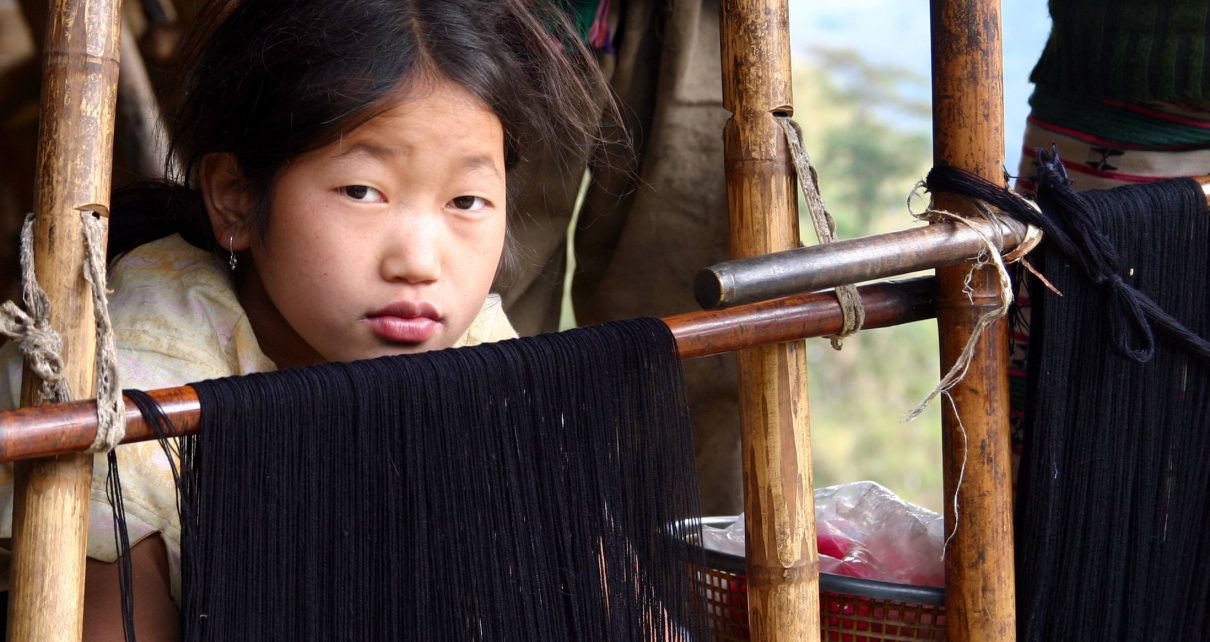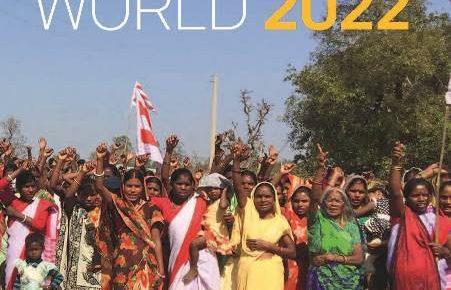WRITTEN ON 06 APRIL 2020
Photo: Chris Erni // IWGIA
Introduction
Coronavirus (COVID-19) has been declared as a pandemic and its impact on the world is yet to be fully assessed. Indigenous peoples living on the margins of the society are unlikely to be considered in the scheme of responses and reactions by most of the States.
India has been affected by COVID-19 too but the scale of infections is still unknown given fewer tests conducted. The tests are expensive – their cost is pegged at Rs 4,500 per test at present[1] and testing facilities only exist in metropolises.
The “Report of the Expert Committee on Tribal Health ‘Tribal Health in India’ Bridging the Gap and a Roadmap for the Future” of the government of India in December 2018 had stated, “104 million tribal people in India are largely concentrated in ten states and in the North-East. Almost 90% of the tribal population of the country lives in rural areas.” [2] It is clear that Indigenous Peoples are unlikely to have access to even test to determine COVID-19 infection in the near future.
The Report of the Expert Committee on Tribal Health further stated, “There are 90 districts or 809 blocks with more than 50% tribal population and they account for nearly 45% of the Scheduled Tribe (ST) population in the country. In other words, almost 55% of the tribal population lives outside these 809 tribal majority blocks.”[3]
Since liberalisation of the Indian economy in 1990s, hundreds of thousands of indigenous peoples migrated to the metropolis, primarily to work in unorganized sectors. As COVID-19 destroys economies and absence of jobs, homes and food loom large; these indigenous migrant workers are all set to return. Reverse migration, possibly carrying the disease can have devastating impact on indigenous communities. It can wipe out endangered indigenous peoples of India and further, permanently damage the survival of many communities.
COVID-19 threatens the survival of some of world’s most endangered tribes
The coronavirus is threatening the survival of some of the world’s most endangered indigenous communities namely Great Andamanese, Jarawas, Onge, Shompen and the Sentinelese of Andaman & Nicobar islands whose combined population is less than 1,000. These ancient tribes with 60 members of Great Andamanese, 124 Onge, 200 Sompen, 520 Jarawas and 60 Sentinelese are already on the verge of extinction.[4]
These tribes are particularly vulnerable to infectious diseases due to their tradition of living in close knit communities and low immunity.
The detection of 10 positive COVID-19 cases (patients are non-tribals) in Port Blair, the capital of Andaman and Nicobar Islands has put the administration on its toes. Nine of these infected people had travelled to Delhi to attend a religious congregation at Nizamuddin Markaz, organised by Tableeghi Jamaat, from 1-15 March 2020 while the tenth patient is the wife of one of those who travelled to Delhi. In addition, over 2,000 persons (non tribals) are under quarantine in Port Blair as on 1 April.[5]
Although as on date, no COVID-19 case has been reported among the tribes, experts and anthropologists have warned that the spread of the deadly coronavirus among the fragile indigenous peoples has the potential to wipe them out. Among them, the Jarawas who live in tribal reserves barely 100 km from capital Port Blair, where the infections have been reported, are the most vulnerable.[6] The administration has closed the Andaman Trunk Road (ATR), banned all commercial and fishing activities and moved the indigenous communities deeper inside forest areas to avoid any contact with the outside world.[7] Any spread of COVID-19 to these communities can be fatal.
There are 75 tribal groups who have been categorized by Ministry of Home Affairs as Particularly Vulnerable Tribal Groups (PVTGs) in 18 States and UT of A&N Islands.[8] They all remain vulnerable. There are reports that the Gotti Koya and other tribals in Mulugu district of Telangana were wearing face masks made of teak leaves[9], tribals in Chhattisgarh’s Bastar district were wearing face masks made from palm leaves[10] and tribals of Vizianagaram district in Andhra Pradesh were covering their faces with mask made from herbal leaves,[11] due to non-availability of protective masks in the tribal areas.
Other impacts of COVID-19 on indigenous peoples in India
The government of India has locked down the country effective from 25 March to 14 April to contain the spread of COVID-19. Prior to the lockdown, indigenous peoples from the North East India faced heightened racism and acts of racial discrimination. It is expected that these incidents shall increase once lockdown restrictions are removed.
There have been loss of jobs and reverse migration of indigenous peoples to their native places. Thousands of indigenous migrant workers have been stranded without home and food in metropolis while there are reports of starvation among indigenous communities in the rural areas. As this is the harvest season, traditional livelihood too will be affected. Hunger looms large on indigenous communities.
Racial discrimination and attacks on Northeast people
While every person in India has been affected by the lockdown, the tribals of the Northeast India living in various cities and towns across the country are facing a problem of different kind, namely racial discrimination based on their Mongoloid features because of the origin of the virus in Wuhan, China. The indigenous peoples of the Northeast come to mainland India for education, employment and medical treatment. On 26 March 2020, the Rights and Risks Analysis Group (RRAG) stated that at least 22 cases of racial discrimination and attacks took place against the Northeast people in various parts of the country from 7 February 2020 to 25 March 2020.[12] Apart from being called “Corona”, “Chinese”, “Chinki”, glaring/staring/ogling while walking in the streets or shopping or sitting in trains, India’s Mongoloid looking people were spat on and called “coronavirus”, forcibly quarantined despite showing no COVID-19 symptoms, denied entry into apartment complexes, forced to leave apartments, threatened with eviction from their apartment, forced to leave restaurants to make others comfortable, none wanting to share transport etc. On 21 March 2020, the Ministry of Home Affairs issued an Advisory to all states directing to take appropriate action when such cases of harassment are reported. Yet there has not been any public statement or condemnation from the politicians from the mainland India or any key leader of the Government of India.[13]
Loss of jobs and reverse migration to native places
Following the nationwide lockdown, all commercial establishments have been closed and this has resulted in joblessness and escaping from cities to their hometowns or villages by lakhs of migrant workers, including tribals.
On 27 March 2020, The Hindu reported that over 30,000 tribal labourers from Jhabua district in Madhya Pradesh have returned from Gujarat, Rajasthan and Maharashtra and another 30,000 from this district were left stranded in these States.[14] Another report by Down To Earth on 25 March 2020 stated that thousands of migrant workers, mostly tribals, returned to their homes in Banswara, Dungarpur, Udaipur, Sirohi of Rajasthan; Jhabua in Madhya Pradesh and tribal districts of Dahod, Panchmahals, Banaskantha, Sabarkantha in Gujarat. Most of them have reportedly walked hundreds of kilometers in absence of public transport.[15]
As a protocol all the migrant workers returning from other States must be screened and required to stay in self-isolation at their respective homes for at least 14 days. But in the absence of adequate space at home, many tribal migrants who returned to their homes in Purulia district in West Bengal had to spend the mandatory 14 days of self-isolation outside the village limits by sleeping on trees, inside trucks or buses and in make-shift shelters.[16]
Indigenous migrant workers stranded by the lockdown without adequate food
Hundreds of tribals have been stranded without adequate food following the lockdown of India.
The New Indian Express on 29 March 2020 reported that about 200 Soliga tribals (migrant labourers) were stranded at coffee estates in a village of Kodagu district near the Karnataka-Kerala border, due to the lockdown and they were running out of food.[17] It has been also reported that many other migrant tribals were stranded in Madikeri, Virajpet and other places in Kodagu district and are living in dire situations.[18] Following the publication of the story, the state government of Karnataka reached out to tribals from Chamarajnagar stranded in Kodagu and supplied 8 kg of ragi, wheat, sugar, jaggery, dal, horse gram, green gram, eggs, ghee and edible oil to the tribal families.[19]
Rajendra Hembr, who is employed in the textile industry in Surat, Gujrat and originally belongs to Giridih in Jharkhand, claimed that 50 of them were stranded in the city as their employers and contractors have left the town and they have no money to feed themselves. He alleged that they cannot even go out as police were standing outside our homes.[20]
Impacts on traditional livelihood of indigenous peoples
The lockdown is affecting the traditional livelihood of the tribals as this is the peak season for selling of Non Timber Forest Products (NTFP), also called Minor Forest Produce (MFP) which according to the Forest Rights Act, 2006 include “all non-timber forest produce of plant origin including bamboo, brush wood, stumps, cane, tussar, cocoons, honey, wax, lac, tendu or kendu leaves, medicinal plants and herbs, roots, tubers and the like”. According to the Ministry of Tribal Affairs, MFP is a major source of livelihood for tribals living in forest areas and around 100 million forest dwellers depend on MFPs for food, shelter, medicines and cash income. It provides them critical subsistence during the lean seasons, particularly for primitive tribal groups such as hunter gatherers, and the landless. Tribals derive 20-40% of their annual income from MFP. MFP sector has the potential to create about 10 million workdays annually in the country.[21]
A number of MFP items are seasonal and the selling off period for those products is usually between March and June. This is the peak season for selling MFP but the tribals are not able to sell as there are no buyers due to the lockdown. The state governments have closed haats to avoid crowding and tribals are unable to sell their forest produce. On 30 March 2020, the Tribal Cooperative Marketing Development Federation of India (TRIFED) sent a proposal to the Ministry of Tribal Affairs to declare the van dhan centres (established for providing skill upgradation for tribal communities) as procurement centres for MFP.[22] The Government of India has assured that the tribals would get minimum support price for the MFP.[23]
Hunger looms large in tribal areas
The Scheduled Tribes have higher poverty rates than the general population. According to the Ministry of Tribal Affairs, ST people living below the poverty line in 2011-12 were 45.3% in the rural areas and 24.1% in the urban areas as compared to 25.7% persons in rural areas and 13.7% persons in urban areas below poverty line for all population.[24] Therefore, it is expected that the tribals in the inaccessible areas shall be worst affected by the lockdown if the local administration does not take proactive measures to reach out to them with food grains and other essential supplies. The tribals already face hunger and suffer from malnutrition but the lockdown, which resulted in restrictions of movement, lack of livelihood sources, and returning of migrant workers, have aggravated the hunger crisis. There are reports that the Gond tribals are surviving on rotis with salt at Darera village in Panna district in Madhya Pradesh.[25]
On 2 April 2020, the Times of India reported that around 70,000 tea workers of Barak Valley region in Assam, belonging to the Adivasi tea tribe community are without ration and wages since 24 March 2020 and are struggling to find one proper meal a day. A total of 104 tea gardens in the state where these communities work are closed due to the lockdown.[26]
The stateless indigenous peoples like the Chakmas and Hajongs of Arunachal Pradesh remain extremely vulnerable as assistance from the State for COVID-19 does not cover them. There have been reports of starvation as since previously they remained excluded from benefits of any of socio-economic schemes such as National Food Security Act, National Rural Employment Guarantee Scheme, rations under the Antoyadaya Scheme, Prime Minister’s flagship health insurance scheme Ayushman Bharat, among others.
Notes and References:
- [1]. Coronavirus test should not cost more than Rs 4,500: Government to private labs, The Economic Times, 22 March 2020 available at https://economictimes.indiatimes.com/news/politics-and-nation/covid-19-test-should-not-cost-more-than-rs-4500-government-to-private-labs/articleshow/74753826.cms?from=mdr
- [2]. Migration of Tribals, Ministry of Tribal Affairs, Government of India, 17 December 2018 available at https://pib.gov.in/Pressreleaseshare.aspx?PRID=1556176
- [3]. Ibid
- [4]. COVID-19 Outbreak: Anthropologists Fear for Safety of Low-immunity Andaman Tribes Should Virus Spreads, News18, 28 March 2020, https://www.news18.com/news/india/covid-19-outbreak-anthropologists-fear-for-safety-of-low-immunity-andaman-tribes-should-virus-spreads-2555247.html
- [5]. Tablighi link to 9 of 10 Andaman Coronavirus cases, The Economic Times, 1 April 2020, https://economictimes.indiatimes.com/news/politics-and-nation/tablighi-link-to-9-of-10-andaman-coronavirus-cases/printarticle/74923065.cms
- [6]. Coronavirus outbreak: Andaman’s indigenous tribes face extinction threat, livemint, 1 April 2020, https://www.livemint.com/news/india/coronavirus-outbreak-andaman-s-indigenous-tribes-face-extinction-threat-11585681835563.html
- [7]. Andaman administration moves to block COVID-19 from reaching indigenous tribals, The Indian Express, 2 April 2020, https://indianexpress.com/article/coronavirus/coronavirus-covid-19-andaman-tribal-groups-precautions-6343567/
- [8]. Particularly Vulnerable Tribal Groups (PVTGs), Ministry of Tribal Affairs, government of India https://tribal.nic.in/pvtg.aspx
- [9]. Combating coronavirus their own way, Mulugu tribals in Telangana wear masks made of leaves, The New Indian Express, 30 March 2020, https://www.newindianexpress.com/states/telangana/2020/mar/30/combating-covid-19-their-own-way-mulugu-tribals-in-telangana-wear-masks-made-of-leaves-2123312.html
- [10]. Tribals In Bastar Make Masks From Palm Leaves, Stay In To Fight COVID-19, NDTV, 26 March 2020, https://www.ndtv.com/india-news/coronavirus-india-news-tribals-in-chhattisgarhs-bastar-make-masks-from-palm-leaves-stay-in-to-fight–2201143
- [11]. Hyderabad lockdown news: Today’s updates from your city, The Times of India, 3 April 2020, https://timesofindia.indiatimes.com/city/hyderabad/coronavirus-in-hyderabad-latest-news-updates-on-hyderabad-corona-cases-deaths-3-april-2020/articleshow/74958972.cms
- [12]. The Rights and Risks Analysis Group (RRAG), “Coronavirus Pandemic: India’s Mongoloid Looking People Face Upsurge Of Racism”, 26 March 2020, http://www.rightsrisks.org/by-country/india/coronavirus-pandemic-indias-mongoloid-looking-people-face-upsurge-of-racism/
- [13]. The Rights and Risks Analysis Group (RRAG), “Coronavirus Pandemic: India’s Mongoloid Looking People Face Upsurge Of Racism”, 26 March 2020, http://www.rightsrisks.org/by-country/india/coronavirus-pandemic-indias-mongoloid-looking-people-face-upsurge-of-racism/
- [14]. A long walk home for 30,000 tribal workers in M.P., The Hindu, 27 March 2020, https://www.thehindu.com/news/national/other-states/a-long-walk-home-for-30000-tribal-workers-in-mp/article31186087.ece
- [15]. COVID-19: Gujarat labourers, tribals forced to take 250 km-long journeys on foot, Down To Earth, 25 March 2020, https://www.downtoearth.org.in/news/health/covid-19-gujarat-labourers-tribals-forced-to-take-250-km-long-journeys-on-foot-69995
- [16]. These Bengal villagers found ways to keep Covid-19 out, instead of waiting for govt help, The Print, 3 April 2020, https://theprint.in/india/these-bengal-villagers-found-ways-to-keep-covid-19-out-instead-of-waiting-for-govt-help/393762/; also see, Walked from Chennai to West Bengal, seven migrants self-isolate on trees to protect family from COVID-19, The New Indian Express, 29 March 2020, https://www.newindianexpress.com/thesundaystandard/2020/mar/29/walked-from-chennai-to-west-bengal-seven-migrants-self-isolate-on-trees-to-protect-family-from-covid-19-2122800.html
- [17]. Soliga tribals run out of food, desperate for vehicles, The New Indian Express, 29 March 2020, https://www.newindianexpress.com/states/karnataka/2020/mar/29/tribals-run-out-of-food-desperate-for-vehicles-2122860.html
- [18]. Soliga tribals run out of food, desperate for vehicles, The New Indian Express, 29 March 2020, https://www.newindianexpress.com/states/karnataka/2020/mar/29/tribals-run-out-of-food-desperate-for-vehicles-2122860.html
- [19]. Karnataka government reaches out to stranded tribals, provides food, The New Indian Express, 30 March 2020, https://www.newindianexpress.com/states/karnataka/2020/mar/30/karnataka-government-reaches-out-to-stranded-tribals-provides-food-2123261.html
- [20]. Gujarat: 96 migrant workers held in Surat after violent clash with police, Deccan Herald, 30 March 2020, https://www.deccanherald.com/national/gujarat-96-migrant-workers-held-in-surat-after-violent-clash-with-police-819202.html
- [21]. Press release titled “Ministry of Tribal Affairs to launch first ever “Van Dhan Vikas Kendra” at Bijapur, Chhattisgarh for value addition of Forest Produce” by the Ministry of Tribal Affairs, 06 April 2018, https://pib.gov.in/newsite/PrintRelease.aspx?relid=178469
- [22]. Coronavirus lockdown: Fear looms large over tribal communities, The New Indian Express, 31 March 2020, https://www.newindianexpress.com/nation/2020/mar/31/coronavirus-fear-looms-large-over-tribal-communities-2123864.html
- [23]. Centre to ensure tribals get MSP for produce, The Economic Times, 1 April 2020, https://economictimes.indiatimes.com/news/economy/agriculture/centre-to-ensure-tribals-get-msp-for-produce/printarticle/74923736.cms
- [24]. Ministry of Tribal Affairs, Annual Report 2018-19, available at https://tribal.nic.in/writereaddata/AnnualReport/AREnglish1819.pdf
- [25]. Amid coronavirus lockdown, Gond tribals survive on roti with salt in Panna, The Hindu, 29 March 2020, https://www.thehindu.com/news/national/amid-coronavirus-lockdown-gond-tribals-survive-on-roti-with-salt-in-panna/article31199200.ece
- [26]. 70,000 tea workers in Barak Valley struggle for survival, Times of India, 2 April 2020, http://timesofindia.indiatimes.com/articleshow/74943252.cms?utm_source=facebook.com&utm_medium=social&utm_campaign=TOIMobile&from=mdr&utm_source=contentofinterest&utm_medium=text&utm_campaign=cppst


